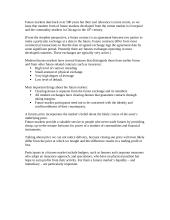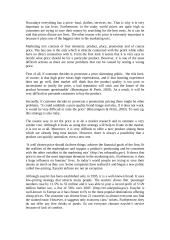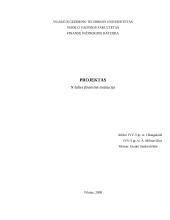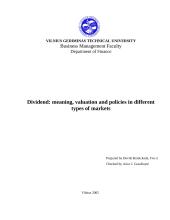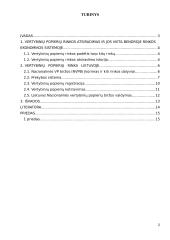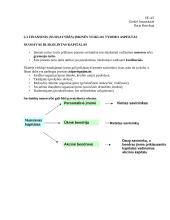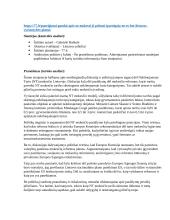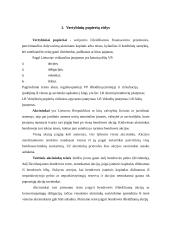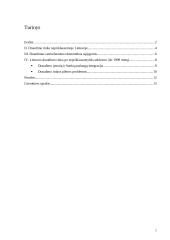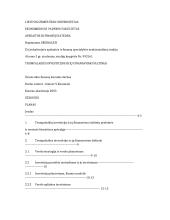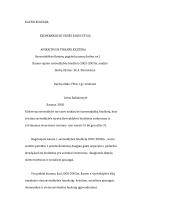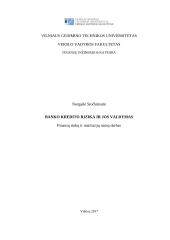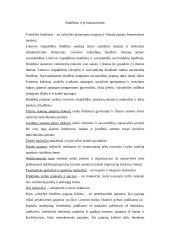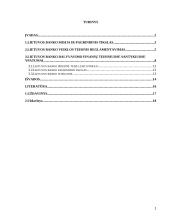Kursiniai darbai
Microcredit. The solution to failures in the credit market
Microcredit The Solution to Failures in the Credit Market Olga Muravjova SSC 362: Economics of the Public Sector University College Utrecht April 27, 2007 Table of Contents 1. Introduction__________________________________________ 3 2. Inefficiency in the credit market_________________________ 4 2.1 Credit constraints___________________________________ 4 2.2 Defining market failures in the credit market_____________ 6 3. Imperfect information in the credit market_______________ 7 3.1 Agency problems___________________________________ 7 3.2 Adverse selection___________________________________ 8 3.3 Moral Hazard______________________________________ 8 4. Microcredit: Group lending____________________________ 9 4.1 The method of group lending: example from Bangladesh____ 10 4.2 Overcoming adverse selection_________________________ 11 4.3 Overcoming moral hazard____________________________ 12 4.4 Limits to group lending______________________________ 13 5. The economic impacts of microcredit_____________________ 14 5.1 How microcredit affects households____________________ 15 5.2 Microcredit: does it work?____________________________ 15 6. Institutions and sustainability___________________________ 16 6.1 The failure of state-owned development banks____________ 16 6.2 Microcredit institutions_______________________________ 17 6.3 Cost-benefit analysis_________________________________ 17 6.4 Smart subsidies_____________________________________ 18 7. Conclusion____________________________________________ 19 8. References____________________________________________ 20 1. Introduction Microcredit is a hot topic among economists and development specialists. The year 2005 was the UN International Year of Microcredit and last year, the Bangladeshi economist Muhammad Yunus, received the Nobel Peace Prize for his pioneering work in the credit market in Bangladesh. Yunus’ non-profit bank offers small loans to people that are not creditworthy. This loan can make the difference in rising people above the poverty line and giving them the opportunity to achieve higher living standards. When Yunus visited some remote villages for the first time, he was shocked by the huge interest rates of over 150 percent, set by village moneylenders. He started wondering why commercial banks are not interested in getting these returns. After some research he concluded that a number of entry barriers exist for banks in developing countries to engage in this business. Lack of information is the critical one. Village moneylenders are better acquainted with the borrowers than banks, and they can keep out unreliable borrowers. Furthermore, they can monitor the behaviour of their clients closely and act on a small scale, which is impossible for banks. These advantages create small monopolies for village lenders in the credit market and this causes serious problems for the population because the high interest rates prevent them from setting up profitable businesses. In short, Yunus’ invention of microcredit entails the forming of a group of borrowers that take a loan together. They can monitor and assist each other and therefore the transaction costs of selecting and monitoring are very low compared to the banks’. Another interesting feature of the system is the fact that the largest part of borrowers is female, because they have proven to be more committed and responsible. Peer pressure has shown to be extremely useful in this respect, resulting in a very high repayment rate. Over time, Yunus’ system has been transformed and applied to many different situations all over the world. In this paper, it will be examined how microcredit can overcome market failures in the credit market and whether non-profit institutions should continue their intervention in the credit market. 2. Inefficiency in the credit market 2.1 Credit constraints For many people in developing countries, such as widows and small-scale peasants, access to credit is difficult. Traditional commercial banks avoid these people, as small loans hardly offer any profit, and the people are too poor to provide any type of collateral. Studies have shown that financial constraints are the main reason why households in the developing world do not start a business, even if they would like to do so (Armendáriz de Aghion and Morduch, 2005: 26). This has important socio-economic consequences, as it has been estimated that the average income of business owners is about three times higher than that of non-business owners. The lack of credit in developing countries is surprising, as the principle of diminishing marginal returns to capital would predict the opposite (ibid.: 5). One of the assumptions of this theory is the concavity of a production function, as shown in figure 1.1. The principle of marginal returns to capital holds that each time an enterprise increases its use of capital, it will produce more output, but the marginal gain per unit of capital will be smaller and smaller. In figure 1.1, it shows that an entrepreneur that uses little capital – such as a tailor in a developing country – can increase output much by buying a sewing machine, while an already capital intensive enterprise would see only a slight increase. Since poor borrowers can expect higher returns on their investments and would therefore also be willing to pay higher interest, capital should naturally flow from the rich to the poor (ibid.). And this should not only hold within a country, but also between countries. The Nobel prize winning economist Robert Lucas Jr. (1990: 92) argues that if trade is free and competitive, new investment will only occur in the less productive (or poorer) countries, since there the marginal product of capital is higher due to low capital levels. Lucas also estimated that the marginal product of capital in India is about 58 times higher than in the US. So why does capital not flow from developed to developing countries, and is it more likely to be the other way around? The answer has to do with risk. Investing in India involves more risk than investing in the US or Europe, for investors are course not able to monitor their investment closely. Even a return of 20 percent will not be attractive for an investor if the probability is high that he will not get his money back (Armendáriz de Aghion and Morduch, 2005: 7). Furthermore, an assumption underlying figure 1.1 is that everything except capital is held constant. However, there are complementary inputs to capital that are also very important for entrepreneurs, such as level of education, business skills and commercial networks. It is not likely to be the case that these are equal among rich and poor countries, and therefore business owners in developing countries that own little capital could still have lower marginal returns than richer entrepreneurs, as is illustrated in figure 1.2 (ibid.: 18) 2.2 Defining market failures in the credit market Because commercial banks often do not provide credit in rural areas, village moneylenders almost have monopolies on the provision of credit. In many countries, this results in extremely high interest rates. For example, Singh (1968: 472) found annual interest rates ranging from 134 to 159 percent in a village in the Punjab region of India. In Thailand, surveys revealed average annual interest rates of 60 percent, and even up to 120 percent in the most remote areas (Armendáriz de Aghion and Morduch 2005: 28). Some people argue that high interest rates are by themselves already enough justification for intervention in the credit market, as they can be seen as exploitative and inefficient. The question can be asked whether high interest rates indeed imply monopoly and inefficiency. Besley (1994) has tried to define what market failures in credit markets are. According to Besley, “a market failure occurs when a competitive market fails to bring about an efficient allocation of credit” (1994: 29). The law of supply and demand also holds for credit. The price of credit, the interest rate, is thereby determined by supply and demand in the market. A market can be called Pareto efficient when it is not possible to make anyone better off without making somebody else worse off. In order words, when there is no possibility for Pareto improvement. When two individuals trade, usually a Pareto improvement will occur. For example, one individual may have an investment opportunity but a lack of capital, while another may have some capital available, and then both could gain from the transaction. The first fundamental welfare theorem holds that if an economy is competitive (and no market failures are present) there will be a Pareto-efficient outcome. However, as Besley has argued, the credit market does not comply with the model of perfect competition, due to enforcement costs and information asymmetries, which will be discussed in chapter 3. Therefore, lenders may decide to offer less credit than what they would have done without these problems, which is inefficient. The exact structure of the credit market is debatable. Several economists have argued that high interest rates do not necessarily imply monopoly and inefficiency, and that rural credit markets are more competitive than often is assumed. Also it has been argued that moneylenders are charging rates that are needed to acquire capital, cover transaction costs, monitor clients and cover risks of default (Armendáriz de Aghion and Morduch 2005: 30). For example, banks or moneylenders typically face relatively high transaction costs in rural and poor areas, since servicing many small transactions is much more expensive than handling one large transaction. Aleem (1990) has done a study on the costs of screening potential borrowers and other costs in a rural money market in Pakistan. His conclusion is that the observed interest rates approximate the average costs of lending, but that they are above marginal costs. Furthermore, entry to the market is relatively free and borrowers view lenders as offering differentiated products. Therefore the credit market seems to fit the Chamberlian model of monopolistic competition. Aleem argues that equilibrium in the market is not efficient, as there are too many lenders, and fixed costs have to be spread over few loans. As a result, the interest rate rises above marginal costs. Studies have shown that marginal costs are also below average costs in Ghana, Malawi, Nigeria and Tanzania (Armendáriz de Aghion and Morduch, 2005: 33). To conclude, even though there seems to be no severe exploitation present in these countries, the market is inefficient, and intervention could “yield a larger pie” (ibid.). 3. Imperfect information in credit markets In developing countries, capital is often not invested in potentially very profitable projects. This has to do with imperfect information. If banks had cheap ways to acquire relevant information on their clients and if they could easily enforce contracts, problems of imperfect information would not exist. Also, if borrowers could provide collateral, the problem would be eliminated. However, they often are not able to do so, and commercial banks therefore face large risks due to imperfect information. Two important notions in this respect are adverse selection and moral hazard. 3.1 Agency problems When a person borrows money from a bank or a village money lender, first of all there is the limited liability problem. Traditional banks usually require collateral, but poor people have difficulties to provide this. One solution could be to establish clear property rights over land and other assets. However, even if these are established, lenders may still find it difficult to seize assets from poor borrowers. A poor legal system is one explanation, but also socially, it may run against the anti-poverty missions of the government and development banks to do so (Armendáriz de Aghion and Morduch, 2005: 36). Furthermore, the so-called ‘principal-agent’ problem arises. The problem refers to the inability of the lender (‘principal’) to observe the project riskiness and the reliability of the borrower (‘agent’), at three different stages. 3.2 Adverse selection First, there is the agency problem that arises before a loan is disbursed. The term ‘adverse selection’ could be used to describe this problem. Banks lack reliable information about the riskiness of each loan, and they have therefore difficulties filtering out the risky borrowers. The problem here is the inherent riskiness of the borrower, so for example whether he is prudent or not, or risk-averse or risk-loving (ibid.: 37). Due to the impossibility of distinguishing the ‘good’ borrowers from the ‘bad’ ones, banks are forced to charge higher interest rates than just the opportunity cost of their capital, to compensate for the high default rates. The individuals with the least risky projects will be most discouraged to borrow, because it is very likely that they will repay their loan and the interest. On the other hand, risky borrowers who know that there is a high chance that they will not be able to repay the loan will be less discouraged to borrow. As profits decrease because the good borrowers are driven out of the market, lenders may again be forced to increase interest rates, and the same story happens again. Rationing credit and excluding people without collateral may thus be a better idea than raising the interest rate (Besley, 1994: 35). In his famous article about the market for lemons, Akerlof (1970) already mentioned that credit markets in the developing world offer a classical example of imperfect information and the ‘Lemons principle’. In India, the banks in the cities charge interest of around 8 percent, in the countryside this percentage may be as high as 25 or even 50 percent for village lenders. Akerlof explains the latter as follows; the village lender only grants credit if he can easily enforce his contract and if he knows the borrower personally. If a middle man tries to offer an interest rate somewhere in between the central bank and the village lender, he is likely to attract not only the creditworthy borrowers, but also many ‘lemons’ that would otherwise not have gotten credit. He would therefore make a loss, keeping him out of the market and thereby allowing the village lender to have a monopolistic position. 3.3 Moral hazard The second stage at which a principal-agent problem arises is after the loan has been given out, but before the project yields any returns. Borrowers at this stage take actions that influence the probability of realizing high returns on their project. However, for the lender these actions and efforts of the borrower are unobservable. The efforts borrowers will put into their project depends very much on “what they have to loose”. When dealing with commercial banks, the threat of loosing its collateral will be an incentive for borrowers to do their best. However, when a poor borrower cannot offer any collateral, he will no longer have an incentive to put the maximum effort into his project. He will rather hope for a good outcome, and if not, it is the bank that will suffer the loss anyway. This behavior is called ex ante moral hazard, because it takes place before returns are realized (ibid.: 43-44). The last stage which knows a principal-agent problem is after the loan has been disbursed and the borrower has realized the project he had invested in with the loan. The term ex post moral hazard is used when a project has been succesful, but still the borrower decides to “take the money and run”. This can happen when lenders are not able to observe the profits that the project has yielded, and therefore losses can falsely be claimed. Also, in some rare cases, the lender has legally not been able to reclaim his money and interest, so when project returns are not verifiable. Banks will no longer give out loans anymore, unless they can pose a threat of not refinancing a borrower in the future. However, this threat is often worthless when borrowers can migrate or change identities (ibid.: 45-46). After having identified the information problems that arise when doing transactions in the rural credit market, it will now be discussed how microcredit is able to resolve these principal-agent problems, even when borrowers are not able to offer any collateral. 4. Microcredit: Group Lending It is common in Bangladesh that a group of forty people from a village meets together with a loan officer from a microcredit association. Villagers are subdivided into eight five-individual groups with each having one chairperson per group. The main task for the loan officer is to check weekly installments on loans outstanding, fees, savings deposits as well as whether the totals add up correctly. In addition, he may give some advice and make arrangements for those who are willing to get new loans. It is important to mention, that in order to make these processes more transparent, everything is done in public, which also provides other villagers with information as who is experiencing problems or who is moving forward (Armendáriz de Aghion and Morduch, 2005: 85). This picture can be seen over 70,000 times each week in Bangladesh and these meetings have been adopted all over the world. Group lending became synonymous with microcredit. In general, group lending can be understood as arrangements by individuals without collateral who get together and form groups with the aim of getting loans from a lender. The important element is that the loans are made individually to group members, but all members in the group face consequences if any member runs into serious repayment difficulties. In the Grameen Bank case, the groups are made up of five people and the fundamental idea of “group responsibility” or “joined liability” coupled with regular group meetings is common across approaches (Armendáriz de Aghion and Morduch, 2005: 86). The advantage of the Grameen Bank weekly group meeting is that the bank comes to the villagers, and if there are any problems, like missing documents, they can be solved immediately. The Bank thus offers the same convenience as a moneylender. In the meantime, loan officers experience some advantages as well. Transactions costs are reduced since the multiple savings and loan transactions of forty people can take place in a short block of time. Moreover, transacting through groups has even more advantages. Particularly, the group responsibility part of contracts can “mitigate the moral hazard, adverse selection, and enforcement problems that crippled previous attempts at lending to the poor by outside financial institutions” (Armendáriz de Aghion and Morduch, 2005: 86). After investigating the problem of asymmetric information, the conclusion was that if the bank can receive more information, it can eventually do better. Thus, a solution to the resulting inefficiency is to create contracts that create better information. However, the contracts described above improve matters without the bank necessarily learning anything new, but the agreements take advantage of the fact that group members themselves may have good information about fellow members. Therefore, the contract gives the members incentives to use their information to the bank’s advantage. Criticism concerning the question of collusion against the microlender by collectively deciding not to repay, peer monitoring and the problem of “free riding” when borrowers cannot observe each other’s effort levels will be discussed later in the paper. 4.1 The Method of Group-Lending: example from Bangladesh The case of “Grameen-style” group lending will be further presented. In the twenty-five years period since it was established, the Grameen Bank in Bangladesh has experienced some changes. The first loans were made to individuals without a group responsibility part. However, “economies of scale motivated the first use of groups”. The costs of screening and monitoring loans and the costs of enforcing debt repayments could be substantially reduced (Yunus, 2002). From the start, the bank has had a system in which two members of each five-person group receive their loans first. If all installments are paid back on time, the initial loans are given to two other members after four or six weeks, and then after another four to six weeks, the group chairperson receives the loan. Although the groups were in the beginning just seen as foundations of solidarity (if one member would experience delay in repayment no further sanctions would be implemented), formal sanctions have gradually become more common. If someone has serious repayment problems, “all group members will be cut off from future borrowing” (Armendáriz de Aghion and Morduch, 2005: 88). In reality, a borrower who does not want to lose access to microcredit loans in the future accepts the possibility of having to help the fellow group members in times of need. If everything goes well with repayments, borrowers then are offered larger loans. The loan sizes grow over the years building credit histories of each borrower. Finally, loans may be enough to build or repair a house or to make an investment like sending a child to university (ibid.). 4.2 Overcoming Adverse Selection When lenders are not able to distinguish risky borrowers from safer ones, the adverse selection problem emerges. As it was mentioned earlier, “adverse selection may lead to credit rationing” since it “induces lenders to charge everyone high interest rates” in order to pay off if very risky borrowers happen to be in the customer population (Armendáriz de Aghion and Morduch, 2005: 89). Both the trouble and the source of inefficiency arise when safe borrowers are thus stopped from applying for loans. However, group lending with joint responsibility can overcome this inefficiency. The most direct mechanism occurs when customers inform banks about the reliability of potential joiners, allowing the bank to adjust terms accordingly (ibid.). The idea that groups are encouraged to be formed on their own is the key solution to the problem of adverse selection. Potential borrowers can then use their information to find the best partners. The safe types stick together based on the assumption of joint-responsibility. The risky borrowers thus are forced to create groups with other risky types, leading to a segregated outcome often referred to in the labor economics literature as “assertive matching” (Armendáriz de Aghion and Morduch, 2005: 91). With the joint-responsibility system, since investment projects undertaken by risky borrowers fail more often than those of safe borrowers, risky borrowers have to repay for their defaulting peers more often or they will be rejected from future credits. Safe borrowers no longer have to carry the burden of default by the risky peers. As the consequence, there is a transfer of risk from the bank onto the risky borrowers themselves. Eventually, the safe types pay lower interest rates than the risky types since they do not have to cross-subsidize risky borrowers anymore. To sum up, “the bank remain as ignorant as ever” regarding of who is risky or safe and all customers are offered exactly the same contracts (Armendáriz de Aghion and Morduch, 2005: 92). All of the action happens under the joint responsibility. Moreover, the average interest rates for both risky and safe types can be reduced while banks still make profits. The lower interest rates in turn bring a secondary positive effect. In the adverse selection problem analyzed before, “safe” borrowers were inefficiently pushed out of the market by high interest rates; here, the reduction in interest charges faced by safe types further encourages them to re-enter the market, mitigating the market failure. 4.3 Overcoming Moral Hazard Once loans have been distributed, moral hazard problems may be faced by the bank, due to the difficulty of monitoring borrowers’ actions (Armendáriz de Aghion and Morduch, 2005: 97). However, it is important to take into account that group members, who often live and work closely together, can impose social and economic sanctions on each other, which banks cannot do. Stiglitz set out an ex ante moral hazard approach to group lending. He argued that the group-lending contract evades ex ante moral hazard by making borrowers to monitor each others’ choice of projects and to impose penalties upon borrowers who ended up with extremely risky projects (Stiglitz, 1990). Economists Laffont and Rey argue that the fact that group members are affected by the actions of other members means that they will take steps to punish anyone who “puts in little effort and thus burdens the group with excessive risks” (Laffont & Rey, 2003). To sum up, the joint responsibility contract relies on the group’s ability to sanction individuals who try to evade. When talking about ex post moral hazard and the role of peer monitoring one has to consider the following. The problem which can occur after production has been completed and profits have been realized is that borrowers can consider leaving the revenues in their pockets without repaying the lender. Group lending with peer monitoring can, however, induce each member to incur a monitoring cost to check the actual revenue realization of her peer. So, with this information the partner can force the peer to repay. Joint responsibility makes lending sustainable by inducing peer monitoring and overcoming enforcement problems associated with ex post moral hazard. So, the group lending again does better that the traditional individual lending contract. 4.4 Limits to Group Lending It was shown that group lending can improve the bank’s performance. However, it is also important to have a look on how the practice of microcredit affects the borrowers’ lives (other than taking into account that access to credit for individuals lacking collateral improves with group lending). There have been fears that group lending can also create peer pressure that works against the poorest and most vulnerable members of the community (ibid.: 101). Group members put high pressure on peers to repay, even in a situation when borrowers faced difficulties beyond their control (Montgomery, 1996: 297). However, in practice, there are usually meetings called “meeting day joint-liability”. The main idea of this kind of meeting is to provide the loan officer with the information regarding which borrowers in the larger, village-level group are finishing up their current loans and are planning to request a next loan. Those individuals are particularly disposed to be pressured to help with problem clients. If “soon-to-borrow-again” customers are not going to help, loan officer might delay the next loan (Armendáriz de Aghion and Morduch, 2005: 102). Group lending has some other disadvantages. According to Armendáriz de Aghion and Morduch, there are “hidden costs, collusion, and emerging tensions” in the microcredit system (2005: 108). Especially, usage of social sanctions has restraints. Typically, social sanctions mean rejecting “problem” borrowers from access to further credit, from social and religious events, or from day-to-day activities (ibid.: 109). Also, one of the concerns on group lending is that attitudes of people are mixed. For example, the complaint can be that it is costly to attend meetings and monitor group members, especially where houses are not close together or people were not satisfied with the frequency of meetings (Women’s World Banking, 2003: 5). Another problem is that group lending works by transferring what are typically the bank’s responsibilities to the borrowers themselves and the responsibilities can carry hidden costs (Armendáriz de Aghion and Morduch, 2005: 110). Group lending can bring risks for borrowers, and if borrowers are risk adverse, those risks can weigh heavily. The contract says: “the borrower is now not just at risk of defaulting on her own, but she also faces the risk that her partner will default also” (ibid.). According to Stiglitz, if monitoring and enforcing contracts is costless, “borrowers can address moral hazard effectively and the risks are minimized” (Stiglitz, 1990). However, monitoring is not costless, even for individuals living close to each other. Monitoring then would be imperfect and would open the way for moral hazard to enter back into the system. Under the group lending contract, however, it is now the group which cares the risk, not the bank. The threat of social sanction can help, but in practice this is applied imperfectly too (ibid.). Furthermore, there is the risk that borrowers may collude against the bank and undermine the bank’s ability to control “social collateral” (Armendáriz de Aghion and Morduch, 2005: 111). In the investigation of moral hazard and group lending by Laffont and Ray, it was shown that close ties and information sharing among borrowers opened the way for contracts that improve on traditional individual-lending contracts. But, on the other hand, the scope of collusion against the lender increases when borrowers share knowledge and social ties (Laffont and Ray, 2003). The final criticism of group lending is that punishments are too harsh. When one borrower out of five members of the group defaults, all four others are cut off from future lending, too. It is that threat that drives the “peer monitoring”, “peer selection” and “peer enforcement” mechanisms (Armendáriz de Aghion and Morduch, 2005: 112). However, particular criticism does not center on the morality of the situation, but rather on its efficiency. In the language of economics, the punishment implies a “deadweight” loss (ibid.). Therefore, punishments need not be levied so directly. The bank together with borrowers tries to take active steps to gather more information when crises emerge. The idea of cross-reports is to elicit truthful information about what has happened and then the microlenders’ staff tries to get as much of the problem loan repaid as possible and then drop just the one defaulter from the group and replace her with an alternative borrower (ibid.: 113). After discussing how group lending works and how information problems can be overcome, the question remains whether microcredit is effective in combating poverty. 5. The economic impacts of microcredit There are numerous examples of people whose lives have been positively affected by microcredit. However, it is difficult to generalize the effects of microcredit, as there are many different forms of microcredit. Furthermore, microcredit might not just affect households on one dimension (economically), but also on other dimensions such as education and nutrition. 5.1 How microcredit affects households When researchers want to conduct research on the effects of microcredit, they first have to ask themselves what exactly they want to measure. Most obviously, microcredit affects the income of households, creating an ‘income effect’. This income effect should stimulate consumption and create a higher demand for children, health care, children’s education and leisure. However, counteracting ‘substitution effects’ will also be present, as running an enterprise costs time and makes time more valuable. When women labour participation increases, the opportunity costs of having children may become higher, thereby decreasing fertility rates. Another example would be that the demand for leisure might actually decrease if incomes from business are high enough (Armendáriz de Aghion and Morduch, 2005: 202). Furthermore, many microcredit instructions try to influence their clients in non-financial ways. For example, they might use the group meetings to educate women on family planning, offer training and education and stress the importance of good health practices. Therefore it is impossible to measure the effects of microcredit only in a financial way. 5.2 Microcredit: Does it work? Most studies try to measure the causal impact of microcredit on the income of the recipient. The most difficult part in doing this is controlling for selection biases. Even if microcredit creates more income for households, the question should be asked whether this would also have happened without microcredit. One important problem is that microcredit clients often already have an initial advantage over their neighbours that do not participate. They might already have been wealthier from the start, or they simply had more entrepreneurial spirit. Still, a number of studies have been successful in isolating the impact of microcredit on the borrowers’ income. For example, studies have estimated the difference between existing clients of a program and incoming clients, so that there would be no difference in their entrepreneurial spirit (ibid.: 200-203). One of the first comprehensive microcredit impact evaluations was done by Hossain (1988). He concluded that member households of the Grameen bank in Bangladesh had on average 43 percent higher incomes than non-members of the same village. However, Hossain already warned that the impact was actually smaller than he estimated, for the microcredit receivers were typically younger and had received a higher education than the non receivers. Khandker and Pitt (1998) were the first to use statistical models to accurately assess the impact of microcredit in Bangladesh. Their main conclusion was that every additional taka that was lent to female borrowers increased household expenditures by 0.18 taka. In 2005, they were even able to improve their model with new data, concluding that this number had even increased to over 0.20 taka. However, for male borrowers they found no returns at all. Another conclusion was that microcredit reduced extreme poverty by 2.2 percentage points per year, while moderate poverty was reduced by 1.6 percentage points per year. These studies are only a tip of the iceberg (see Goldberg 2005 for an overview), but most of them seem to indicate that microcredit can work and that it can increase households income. Furthermore, Goldberg (2005: 46) has found that access to microcredit can also improve children’s nutrition and their education, among many other outcomes. However, it should be kept in mind that there are many different types of microcredit in many different regions of the world, so it is impossible to give a definite answer to whether ‘microcredit works’. 6. Institutions and sustainability 6.1 The failure of state-owned development banks The success of microcredit partly depends on studying the mistakes of the past. After World War II, large state agricultural banks were set up in underdeveloped countries to provide subsidized credit to farmers, in the hope of increasing agricultural productivity. In many countries, subsidies were used to lower interest rates for poor borrowers. However, in the Philippines, this turned out to be disastrous, as David (1984: 222) concludes: “credit subsidies through low interest rates worsen income distribution because only a few, typically well-off farmers, receive the bulk of the cheap credit. When interest rates are not allowed to reflect costs of financial intermediation, wealth and political power replace profitability as the basis of allocating credit.” Also in India, achieving social goals became more important than efficiency. The resources that were used to keep credit cheap for socially excluded groups and women did not lead to good institutional performance. The repayment rate first dropped below 60 percent, and around 2000 it was even just 31 percent (Armendáriz de Aghion and Morduch, 2005: 9). There has been much criticism on government-led development banks. One of the main problems was considered to be the failure of taking into account incentive effects that might occur. Secondly, subsidized banks often pushed informal lenders out of the market, while many poor relied on them. Thirdly, subsidies broke down the rationing mechanism of credit, which now was no longer allocated on the basis of economic potential, but on political or social grounds. Lastly, government credit programs in Africa, the Middle East, Latin America and Asia almost all have default rates ranging from 40 to 95 percent (ibid.: 10). This is due to the fact that many borrowers view the money as grants instead of loans. As Armendáriz de Aghion and Morduch (2005: 11) argue, this ‘failure of state-owned development banks’ is the main reason why the microfinance movement started to look at the private sector for inspiration. 6.2 Microcredit institutions Microcredit distinguishes itself from state-subsidized credit through the fact that it is market-based and does not get the large subsidies that made large state banks collapse. However, the microcredit movement also takes advantage of subsidies, and only approximately half of the microlenders all over the world is financially sustainable (ibid.: 232). It should be taken into account that the microcredit movement consists of very many non-profit institutions, with different sizes but also different objectives. Some focus on social goals, while others are more concerned with financial development. One could ask the question whether it is really a problem if institutions focusing on social change are subsidized, provided that they are cost-effective of course. 6.3 Cost-benefit analysis There have only been two studies that have seriously tried to weigh costs and benefits of subsidized credit (see Armendáriz de Aghion and Morduch, 2005: 242-243). They both found that it could yield social benefits that outweigh the costs. However, this is difficult to establish, as only measurable benefits can be used. Women empowerment for instance, is difficult to include in the analysis. Furthermore, such cost-benefit analyses fail to consider future benefits sufficiently. If credit is invested in a machine for example, it will not only increase income in the current year, but also in the future. Therefore, it is important to compare costs to the prevent value of future benefits, and not against the current impact. This makes the credit program even more attractive (ibid.) 6.4 Smart subsidies Even though the argument for subsidies can be compelling, as discussed above, proponents of microcredit’s financial sustainability argue that subsidies should not have a place in the long-term financing of microcredit. On the other hand, Armendáriz de Aghion and Morduch (2005: 245), present “smart subsidies”, which are “carefully designed interventions that seek to minimize distortions, mistargeting, and inefficiencies while maximizing social benefits.” The first ones they present are subsidies that do not subsidize interest rates, but only start-up costs. This can be the case when scale economies decrease costs over time and programs after for example six years might be able to finance themselves. After this period of subsidies, microcredit institutions should find other way to mobilize capital, for example by offering savings deposits (ibid.: 16). This argument for early subsidization can also be found in international trade theory as the ‘infant industry’ argument. However, it is often difficult to get institutions off subsidies after a long time, and therefore clear goals should be set that encourage microlenders to cut costs sufficiently before the subsidies are removed (ibid.: 247) The second proposal is strategic subsidization over the long term. It is often the case that microcredit banks make a loss on the service of initial small loans to the very poor, because they cost more per dollar than large loans. For each loan, no matter what size, some fixed costs are involved, mainly administration costs. To keep interest rates at an appropriate level, some of the costs on small loans should be subsidized. Cross-subsidization between large and small loans is not an alternative, as the higher interest rates may make borrowers of large loans run off to competitors (ibid.: 250). 7. Conclusion Interventions such as the creation of microcredit institutions should be based on understanding how the credit market functions and which market failures are present. As has been shown, the credit market approximates the model of monopolistic competition, and is therefore inefficient. This inefficieny is created by information asymmetries; especially adverse selection and moral hazard, which are due to the impossibility of commercial banks to observe the characteristics and the actions of its borrowers. Microcredit then comes into the picture, being able to overcome these information problems of adverse selection and moral hazard. It works through the principle of group lending and joint responsibility. The most important feature of microcredit is that the responsibility is turned to the clients’ side (screening potential customers, monitoring their efforts, and enforcing contracts). The group-lending contract provides a way to achieve efficient outcomes even when the lender remains unaware or unable to effectively enforce contracts. Customers get loans that would otherwise be inaccessible or at least that would not be available for them at such low interest rates. The question remains whether microcredit institutions should continue their intervention in the credit market. There are numerous examples of people whose lives have been positively affected by microcredit. However, it is difficult to generalize the effects of microcredit, as there are many different forms of microcredit and its effects are not measurable only in economic terms. Still, most studies that have been done on the impact of microcredit seem to indicate that microcredit works and that it can increase households’ income significantly. Therefore, we think that the provision of microcredit should be continued in developing countries, as it may be the only way for poor people to start their own business and escape poverty. Finally, even though microcredit seems to be a good solution to overcome poverty in developing countries, it can be debatable whether subsidies should be given to microcredit institutions. From the viewpoint of financial sustainability, subsidies are undesirable, but on the other hand social benefits often outweigh costs. Furthermore, subsidies do not necessarily have to undermine efficiency, if they are well designed. Therefore, we think that in some cases, the provision of subsidies is justified, provided that they are carefully allocated and evaluated and that certain social goals are being achieved. 8. References Akerlof, George. 1970. “The market for lemons: Quality uncertainty and the market mechanism”, Quarterly journal of economics, Volume: 84, Issue: 3, August 1970, pp. 488-500 Aleem, Irfan.1990. “Imperfect Information, Screening, and the Costs of Informal Lending: A Study of a Rural Credit Market in Pakistan”, The World Bank Economic Review, Volume: 4, No. 3, pp. 329-349 Armendáriz de Aghion. 2005. Beatriz and Jonathan Morduch, The Economics of Microfinance, MIT Press, Cambridge Massachusetts Besley, Timothy. 1994. “How do market failures justify interventions in rural credit markets? The World Bank Research Observer, Volume 9, No. 1 (January 1994), pp. 27-47 Bouman, Fritz. 1995. “Rotating and accumulating savings and credit associations: A development perspective.” World Development 23(3), pp. 371-384. David, Cristina. 1984. “Credit and price policies in Philippine agriculture.” In Dale W. Adams, Douglas H. Graham, and J.D. von Pischke, eds., Undermining Rural Development with Cheap Credit. Boulder, CO: Westview Press Goldberg, Nathanael. 2005. “Measuring the Impact of Microfinance: Taking Stock of What We Know”, Grameen Foundation USA Publication Series Hossain, Mahabub. 1988. Credit for alleviation of rural poverty: The Grameen Bank of Bangladesh. Institute Research Report 65, February. Washington, DC: International Food Policy Research. Khandker, Shahidur R. and Mark M. Pitt. 1998. “The Impact of Group-Based Credit Programs on Poor Households in Bangladesh: Does the Gender of Participants Matter?”, Journal of Political Economy, Volume 106, no. 5 Laffont, Jean-Jacques, and Patrick Rey. 2003. “Collusion and group lending with moral hazard.” Draft, IDEI, Toulouse and University of Southern California. Lucas, Robert E., Jr. 1990. “Why doesn’t capital flow from rich to poor countries?”, American Economic Review Papers and Proceedings 80(2), May 1990, pp. 92-96 Montgomery, Richard. 1996. “Disciplining or protecting the poor? Avoiding the social costs of peer pressure in micro-credit schemes.” Journal of International Development 8(2) (March-April): 289-305. Mosley, Paul. 1996. “Indosia: BKK, KURK, and the BRI Unit Desa Institutions.” In David Hulme and Paul Mosley, eds., Finance Against Poverty. London: Routledge. Prinz, Michael. 2006. “Consumer co-operatives’ history with politics left in: The German case. Co-operative Enterprises and Co-operative Networks: Successes and Failures”. IEHC Singh, Kareem. 1968. “Structure of interest rates on consumption loans in an Indian village”, Asian Economic Review 10(4), August 1968, pp: 471-475 Stiglitz, Joseph. E. 1990. “Peer monitoring and credit markets.” World Bank Economic Review 4(3), pp. 351-366. Stiglitz, Joseph. E. 2000. Economics of the Public Sector, 3rd Edition, New York: Norton. Yunus, Muhammad. 2002. “Grameen Bank II: Designed to open new possibilities.” Dhaka: Grameen Bank. Women’s World Banking. 2003. “What do microfinance customer value?” What Works 1(1). New York: Women’s World Banking.
Šį darbą sudaro 7051 žodžiai, tikrai rasi tai, ko ieškai!
★ Klientai rekomenduoja
Šį rašto darbą rekomenduoja mūsų klientai. Ką tai reiškia?
Mūsų svetainėje pateikiama dešimtys tūkstančių skirtingų rašto darbų, kuriuos įkėlė daugybė moksleivių ir studentų su skirtingais gabumais. Būtent šis rašto darbas yra patikrintas specialistų ir rekomenduojamas kitų klientų, kurie po atsisiuntimo įvertino šį mokslo darbą teigiamai. Todėl galite būti tikri, kad šis pasirinkimas geriausias!
Norint atsisiųsti šį darbą spausk ☞ Peržiūrėti darbą mygtuką!
- Finansų kursinis darbas
- 21 psl., (7051 ž.)
- Word failas 118 KB
- Lygis: Universitetinis
Mūsų mokslo darbų bazėje yra daugybė įvairių mokslo darbų, todėl tikrai atrasi sau tinkamą!
Panašūs darbai
Kiti darbai
Privalumai
Atsisiuntei rašto darbą ir neradai jame reikalingos informacijos? Pakeisime jį kitu nemokamai.
Pirkdamas daugiau nei vieną darbą, nuo sekančių darbų gausi 25% nuolaidą.
Išsirink norimus rašto darbus ir gauk juos akimirksniu po sėkmingo apmokėjimo!
Atsiliepimai


























